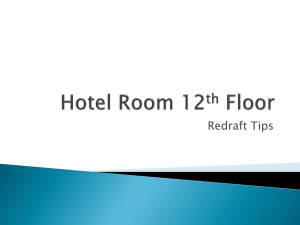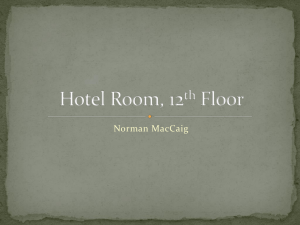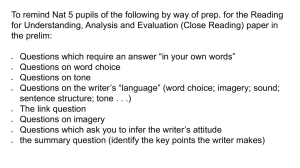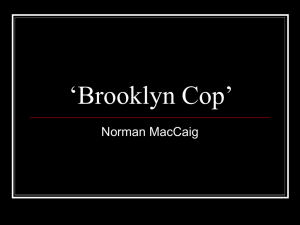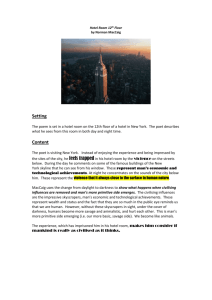Hotel Room Essay
advertisement
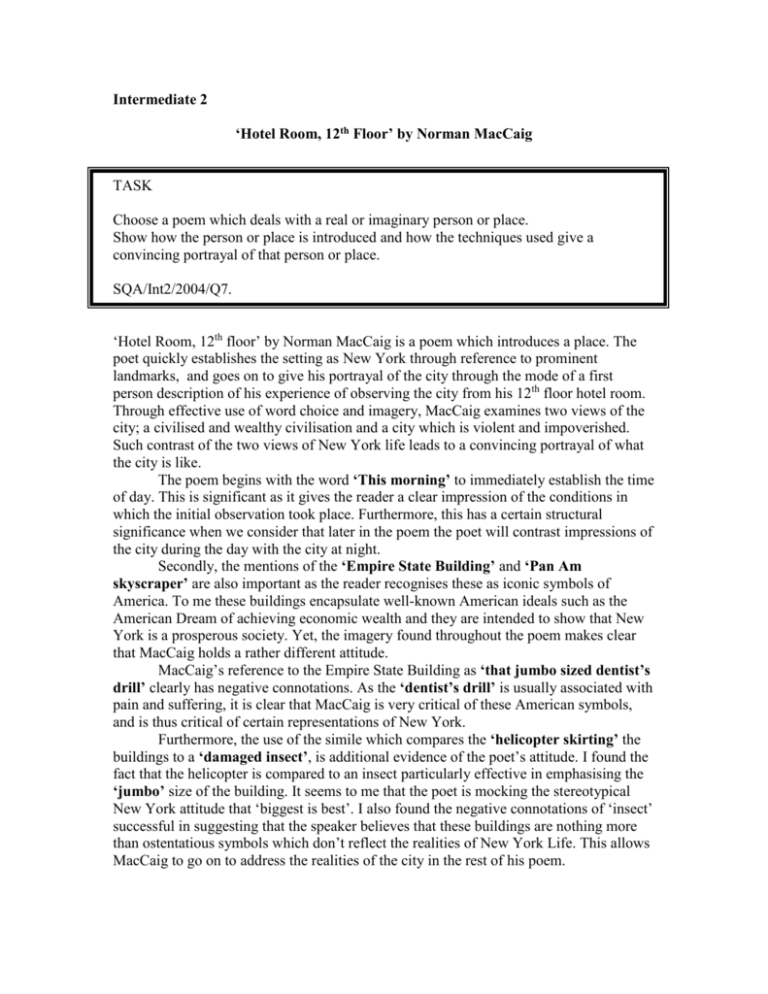
Intermediate 2 ‘Hotel Room, 12th Floor’ by Norman MacCaig TASK Choose a poem which deals with a real or imaginary person or place. Show how the person or place is introduced and how the techniques used give a convincing portrayal of that person or place. SQA/Int2/2004/Q7. ‘Hotel Room, 12th floor’ by Norman MacCaig is a poem which introduces a place. The poet quickly establishes the setting as New York through reference to prominent landmarks, and goes on to give his portrayal of the city through the mode of a first person description of his experience of observing the city from his 12th floor hotel room. Through effective use of word choice and imagery, MacCaig examines two views of the city; a civilised and wealthy civilisation and a city which is violent and impoverished. Such contrast of the two views of New York life leads to a convincing portrayal of what the city is like. The poem begins with the word ‘This morning’ to immediately establish the time of day. This is significant as it gives the reader a clear impression of the conditions in which the initial observation took place. Furthermore, this has a certain structural significance when we consider that later in the poem the poet will contrast impressions of the city during the day with the city at night. Secondly, the mentions of the ‘Empire State Building’ and ‘Pan Am skyscraper’ are also important as the reader recognises these as iconic symbols of America. To me these buildings encapsulate well-known American ideals such as the American Dream of achieving economic wealth and they are intended to show that New York is a prosperous society. Yet, the imagery found throughout the poem makes clear that MacCaig holds a rather different attitude. MacCaig’s reference to the Empire State Building as ‘that jumbo sized dentist’s drill’ clearly has negative connotations. As the ‘dentist’s drill’ is usually associated with pain and suffering, it is clear that MacCaig is very critical of these American symbols, and is thus critical of certain representations of New York. Furthermore, the use of the simile which compares the ‘helicopter skirting’ the buildings to a ‘damaged insect’, is additional evidence of the poet’s attitude. I found the fact that the helicopter is compared to an insect particularly effective in emphasising the ‘jumbo’ size of the building. It seems to me that the poet is mocking the stereotypical New York attitude that ‘biggest is best’. I also found the negative connotations of ‘insect’ successful in suggesting that the speaker believes that these buildings are nothing more than ostentatious symbols which don’t reflect the realities of New York Life. This allows MacCaig to go on to address the realities of the city in the rest of his poem. Towards the end of the first verse, the time changes from day to night. This is indicated with the turning point: “But now midnight has come in” Here, the word ‘but’ marks the change, while the word ‘midnight’ explains that there has been not only a change in time of day, but a change in mood. The fact that we associate midnight with fear and darkness is significant and it is clear that MacCaig intends us to see the words ‘midnight’ and evil as interchangeable. This indicates that the poem will now deal with the more sinister, yet realistic side of the city. MacCaig also suggests that the city is struggling to battle against the forces of evil which have gripped its streets. This corroborates common perceptions of New York as crime ravaged areas, and thus is effective in giving a convincing portrayal of the place. Furthermore, it is made clear that good is attempting to challenge this evil: …Its uncivilised darkness is shot at by a million lit windows, all ups and acrosses” Again, this shows how the poet’s reliance on aspects of light and darkness to symbolise the key theme of good versus evil. This suggests that even during night, in some ways the city will fight back. Here the ‘million lit windows’ represent good fighting back. It has been suggested that this image has religious connotations as ‘ups and acrosses’ could be recognises as the forming of a crucifix shape fighting the evil. Equally, the start of the second verse suggests that the battle is almost lost, and good cannot win out: “But midnight is not so easily defeated…” If we consider this to be a continuation of the religious imagery of the preceding verse, we can consider this to be a comment on the fact that society is beyond redemption from the evils that go on within it. This stems from the notion that the lord was crucified as a means of redeeming us; yet, the metaphorical attack by the ‘ups and acrosses’ cannot save the doomed New York society. Indeed, images of the city as a threatening and scary place are continued with imagery describing the sights and sounds of the streets below that can be heard from the speaker’s hotel room: “the wildest of warhoops continually ululating through the glittering canyons and gulches – police cars and ambulances racing to the broken bones...” This exemplifies the dangers to be found on the streets below as the use of wild-west imagery comparing the sounds on the streets of New York to the threatening war cries of an Indian brave. This allows me to appreciate the threatening nature of the city. Furthermore, the use of the onomatopoeic word ‘ululating’ gives the impression that the sound is a constant backdrop to the city. The description of the police cars and ambulances makes me realise the city is full of violence. In addition, the synecdoche ‘broken bones’ highlights that the casualties of this war between good and evil are seen simply as bones rather than people. This conveys the uncaring nature of the city. Thus, the description of the violent streets gives a convincing portrayal of the city. Another way in which the city is portrayed well is through the references to poverty: “the harsh screaming from coldwater flats…” This illustrates how unpleasant life in the city is as the ‘harsh screaming’ would be an unpleasant sound to the listener in the hotel room. The fact that this noise is descending from ‘coldwater flats’ suggests that such pain is partly due to poor living conditions as these flats do not even have hot water. This is clearly in stark contrast to the symbols of great wealth and power described in the first verse. Therefore, I feel that MacCaig is suggesting that New York is in reality far from the civilised society often portrayed. Finally, the last verse of the poem offers a strong conclusion that suggests that the darkness and evil presence within the city cannot be overcome. This presence is of course a result of human nature: there is evil within us all and we are no more civilised now than in the days of the wild-west: “The frontier is never somewhere else. And no stockades can keep the midnight out.” Here the use of ‘never’ and ‘no’ emphasises that the ‘midnight’ or evil is here to stay in New York and no defences can change this. I found this an effective conclusion to the poem as it challenges the positive perceptions generally associated with life in this city. Overall, it can be seen that ‘Hotel Room, 12th Floor’ by Norman MacCaig offers an effective portrayal of the city of New York. His critique of the representation of America as a prosperous society employs imagery to allow us to appreciate his negative feelings towards the city and its landmarks. Furthermore, his treatment of the theme of good versus evil through the symbolism of light and darkness, and descriptions of the sights and sounds from the streets made the portrayal of the place convincing.


